A Quantitative Approach to Prior Setting for Relative Biomass (B/k) in CMSY++: Application to Snow Crabs (Chionoecetes opilio) in Korean Waters
Abstract
1. Introduction
2. Materials and Methods
2.1. Bayesian Schaefer Model (BSM)
2.2. Used Data
2.3. Prior Information
2.3.1. Resilience
2.3.2. Quantitative Prior Setting for Relative Biomass (B/k)
2.4. Model Diagnostics
3. Results
3.1. Trends in Catch and CPUE
3.2. B/k Prior Estimation Based on Quantitative Indicators
3.3. Stock Status
3.3.1. Biomass and Exploitation Estimates
3.3.2. Model Diagnostics
3.3.3. Integrated Stock Status and Uncertainty Grid
4. Discussion
Author Contributions
Funding
Institutional Review Board Statement
Data Availability Statement
Conflicts of Interest
Abbreviations
| TAC | Total Allowable Catch |
| BSM | Bayesian Schaefer Model |
| CPUE | Catch Per Unit Effort |
| MSY | Maximum Sustainable Yield |
Appendix A
| Data | Time Period | Source |
|---|---|---|
| Catch | 1970–2023 | Korea Statistical Information Service (KOSIS): https://kosis.kr/index/index.do (accessed on 18 January 2025) |
| Sales amount | 1990–2023 | Korea Statistical Information Service (KOSIS): https://kosis.kr/index/index.do (accessed on 18 January 2025) |
| TAC quota | 2002–2023 | Korea Fisheries Resources Agency (FIRA): https://www.data.go.kr/data/15127264/fileData.do (accessed on 18 January 2025) |
| Size in catch | 2012–2023 | National Institute of Fisheries Science (NIFS) |
References
- Jadamec, L.S.; Donaldson, W.E.; Cullenberg, P. Biological Field Techniques for Chionoecetes Crabs; NOAA: Silver Spring, MD, USA, 1999. Available online: https://repository.library.noaa.gov/view/noaa/45839 (accessed on 2 July 2024).
- Korean Statistical Information Service (KOSIS). Fishery Production Statistics. 2025. Available online: https://www.kosis.kr/index/index.do (accessed on 18 January 2025).
- Murphy, J.T. Temporal and spatial variability in size-at-maturity for the eastern Bering Sea snow and Tanner crab (Chionoecetes opilio and C. bairdi). Fish. Res. 2021, 234, 105761. [Google Scholar] [CrossRef]
- Shibata, Y.; Nagao, J.; Narimatsu, Y.; Morikawa, E.; Suzuki, Y.; Tokioka, S.; Okamura, H. Estimating the maximum sustainable yield of snow crab (Chionoecetes opilio) off Tohoku, Japan via a state-space stock assessment model with time-varying natural mortality. Popul. Ecol. 2021, 63, 41–60. [Google Scholar] [CrossRef]
- Hamabe, K.; Fujiwara, K.; Ichinokawa, M. Development of a stock-specific management procedure for snow crab fishery in the Sea of Japan using conditioned surplus production models in a data-moderate situation. Can. J. Fish. Aquat. Sci. 2025, 82, 1–13. [Google Scholar] [CrossRef]
- Lee, H.G.; Lee, B.R.; Lee, J.H.; Lee, S.J.; Ji, H.S. Vertical distribution characteristics of snow crab Chionoecetes spp. larvae in the East Sea. Korean J. Fish. Aquat. Sci. 2023, 56, 221–227. [Google Scholar] [CrossRef]
- Chun, Y.Y.; Lee, S.I.; Yoon, S.C.; Cha, H.K.; Kim, J.B. Molting and growth of the snow crab Chionoecetes opilio in the East Sea of Korea. Korean J. Fish. Aquat. Sci. 2009, 42, 380–386. [Google Scholar] [CrossRef]
- Chun, Y.Y.; Hong, B.G.; Hwang, K.S.; Cha, H.K.; Lee, S.I.; Hwang, S.J. Maturation of reproductive organs and spawning of the snow crab Chionoecetes opilio from the East Sea of Korea. Korean J. Fish. Aquat. Sci. 2008, 41, 119–124. [Google Scholar] [CrossRef]
- Winker, H.; Carvalho, F.C.; Kapur, M. JABBA: Just Another Bayesian Biomass Assessment. Fish. Res. 2018, 204, 275–288. [Google Scholar] [CrossRef]
- Pedersen, M.W.; Berg, C.W. A stochastic surplus production model in continuous time (SPiCT). Fish Fish. 2017, 18, 226–243. [Google Scholar] [CrossRef]
- Froese, R.; Demirel, N.; Coro, G.; Winker, H. User Guide for CMSY++; GEOMAR: Kiel, Germany, 2021; p. 17. Available online: https://oceanrep.geomar.de/id/eprint/52147/ (accessed on 2 July 2024).
- Froese, R.; Winker, H.; Coro, G.; Palomares, M.-L.D.; Tsikliras, A.C.; Dimarchopoulou, D.; Touloumis, K.; Demirel, N.; Vianna, G.M.S.; Scarcella, G.; et al. New developments in the analysis of catch time series as the basis for fish stock assessments: The CMSY++ method. Acta Ichthyol. Et Piscat. 2023, 53, 173–189. [Google Scholar] [CrossRef]
- National Institute of Fisheries Science (NIFS). A Study on Stock Assessment and Management Strategy Evaluation for Coastal and Offshore Fisheries; Report; NIFS: Busan, Republic of Korea, 2024. [Google Scholar]
- Jung, N.Y. CPUE Standardization of Sailfin Sandfish (Arctoscopus japonicus) in Korean Waters Using Fishery Data from Fishery Radio Station. Master’s Thesis, Pukyong National University, Busan, Republic of Korea, 2024. [Google Scholar]
- Holling, C.S. Resilience and stability of ecological systems. In Foundations of Socio-Environmental Research: Legacy Readings with Commentaries; Cambridge University Press: Cambridge, UK, 2022; pp. 460–482. [Google Scholar] [CrossRef]
- Froese, R.; Demirel, N.; Coro, G.; Kleisner, K.M.; Winker, H. Estimating fisheries reference points from catch and resilience. Fish Fish. 2017, 18, 506–526. [Google Scholar] [CrossRef]
- SeaLifeBase. 2024. Available online: http://www.sealifebase.org (accessed on 15 September 2024).
- Gelman, A.; Carlin, J.B.; Stern, H.S.; Dunson, D.B.; Vehtari, A.; Rubin, D.B. Bayesian Data Analysis, 3rd ed.; CRC Press: Boca Raton, FL, USA, 2013. [Google Scholar]
- Mullowney, D.R.J.; Baker, K.D. Multi-indicator precautionary approach frameworks for crustacean fisheries. Can. J. Fish. Aquat. Sci. 2023, 80, 1207–1220. [Google Scholar] [CrossRef]
- Hilborn, R.; Walters, C.J. Quantitative Fisheries Stock Assessment: Choice, Dynamics and Uncertainty; Chapman and Hall: New York, NY, USA, 1992. [Google Scholar]
- Cai, K.; Kindong, R.; Ma, Q.; Tian, S. Stock assessment of Chub Mackerel (Scomber japonicus) in the Northwest Pacific using a multi-model approach. Fishes 2023, 8, 80. [Google Scholar] [CrossRef]
- Bouch, P.; Minto, C.; Reid, D.G. Comparative performance of data-poor CMSY and data-moderate SPiCT stock assessment methods when applied to data-rich, real-world stocks. ICES J. Mar. Sci. 2021, 78, 264–276. [Google Scholar] [CrossRef]
- Yoon, S.C.; Kim, M.-J.; Kang, H.; Choi, M.-J. Reconstruction of recreational catch and multi-fisheries stock assessment of Hairtail (Trichiurus lepturus) in Korean waters under a data-limited situation. Fishes 2025, 10, 166. [Google Scholar] [CrossRef]
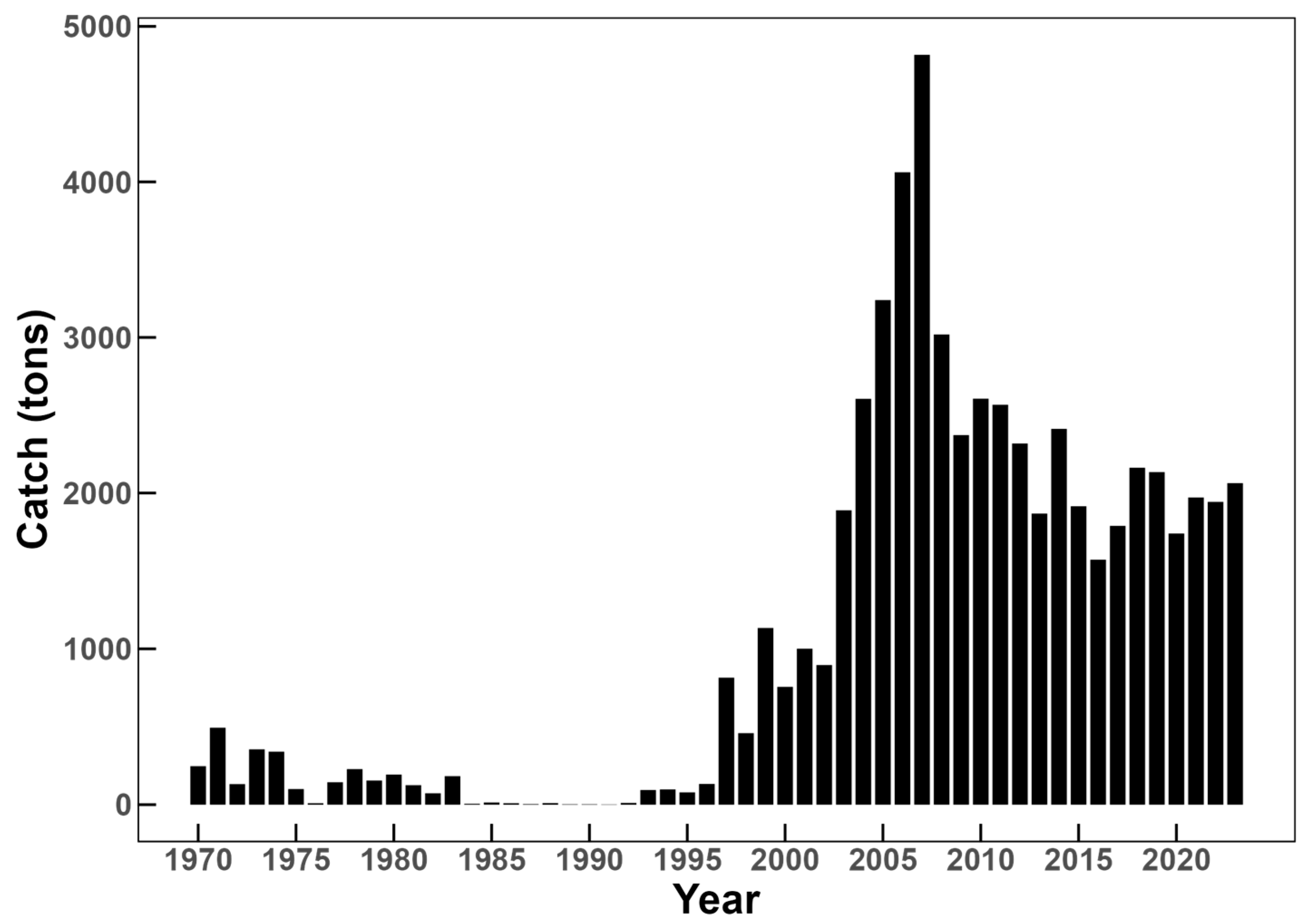
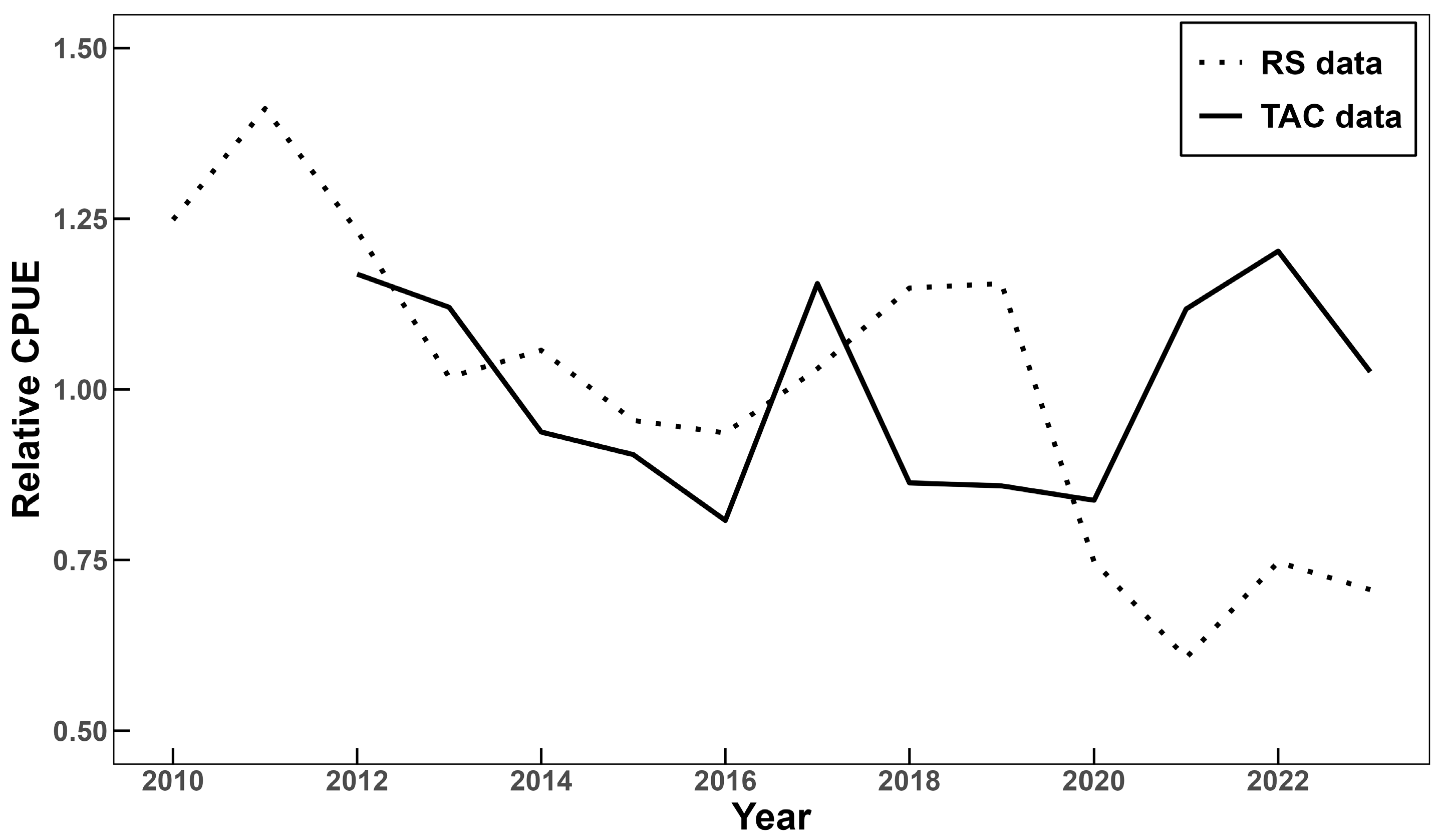

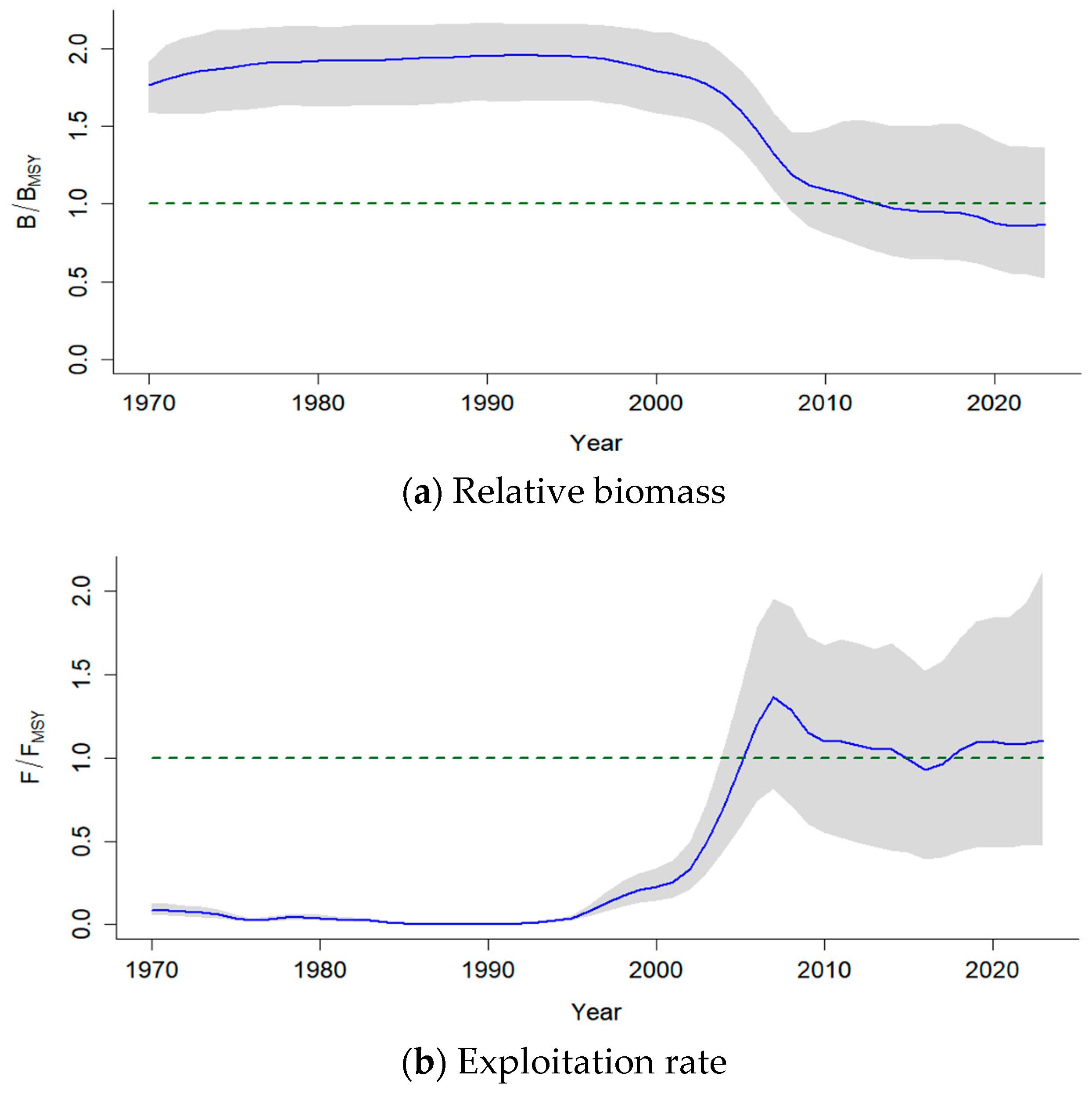
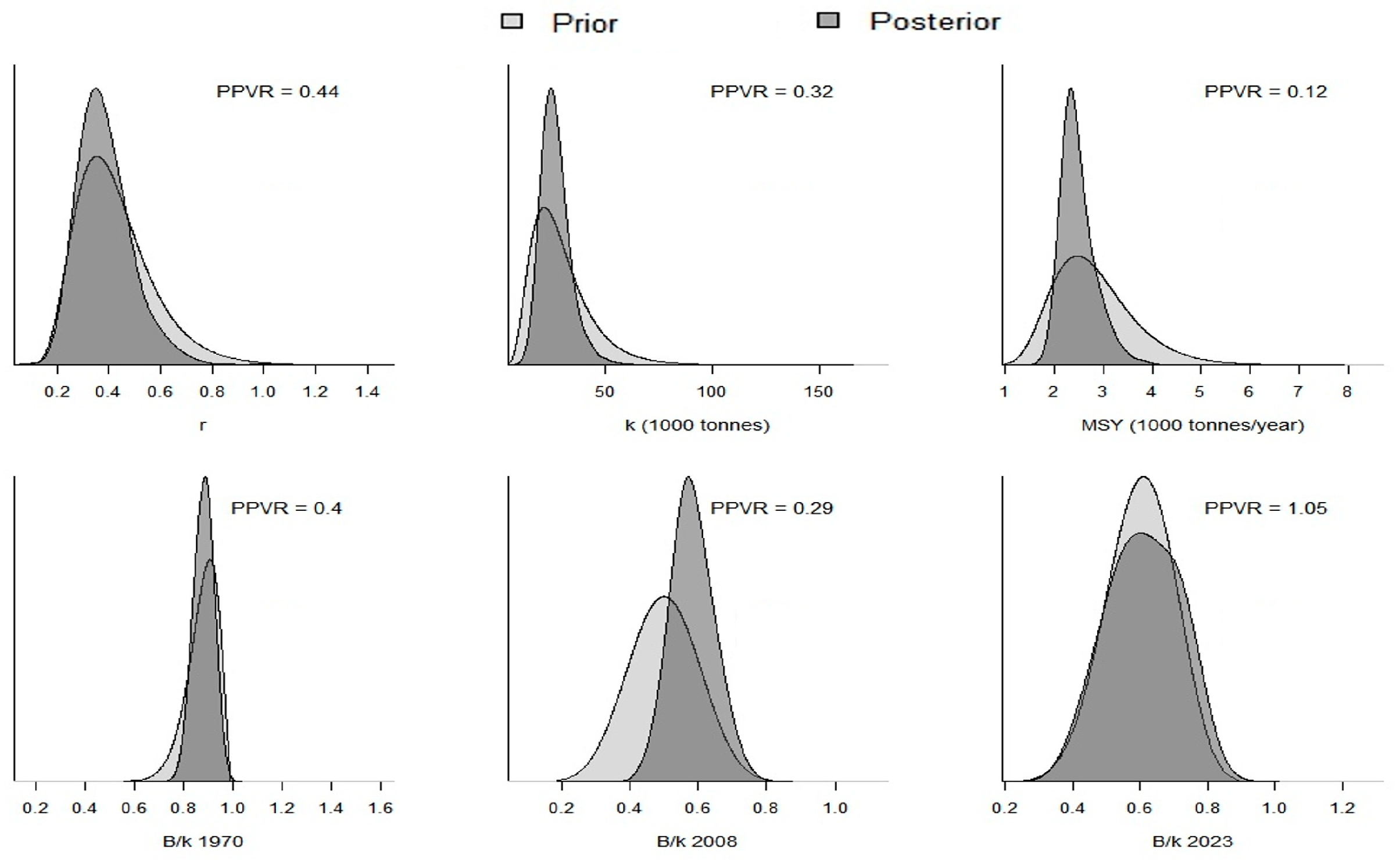
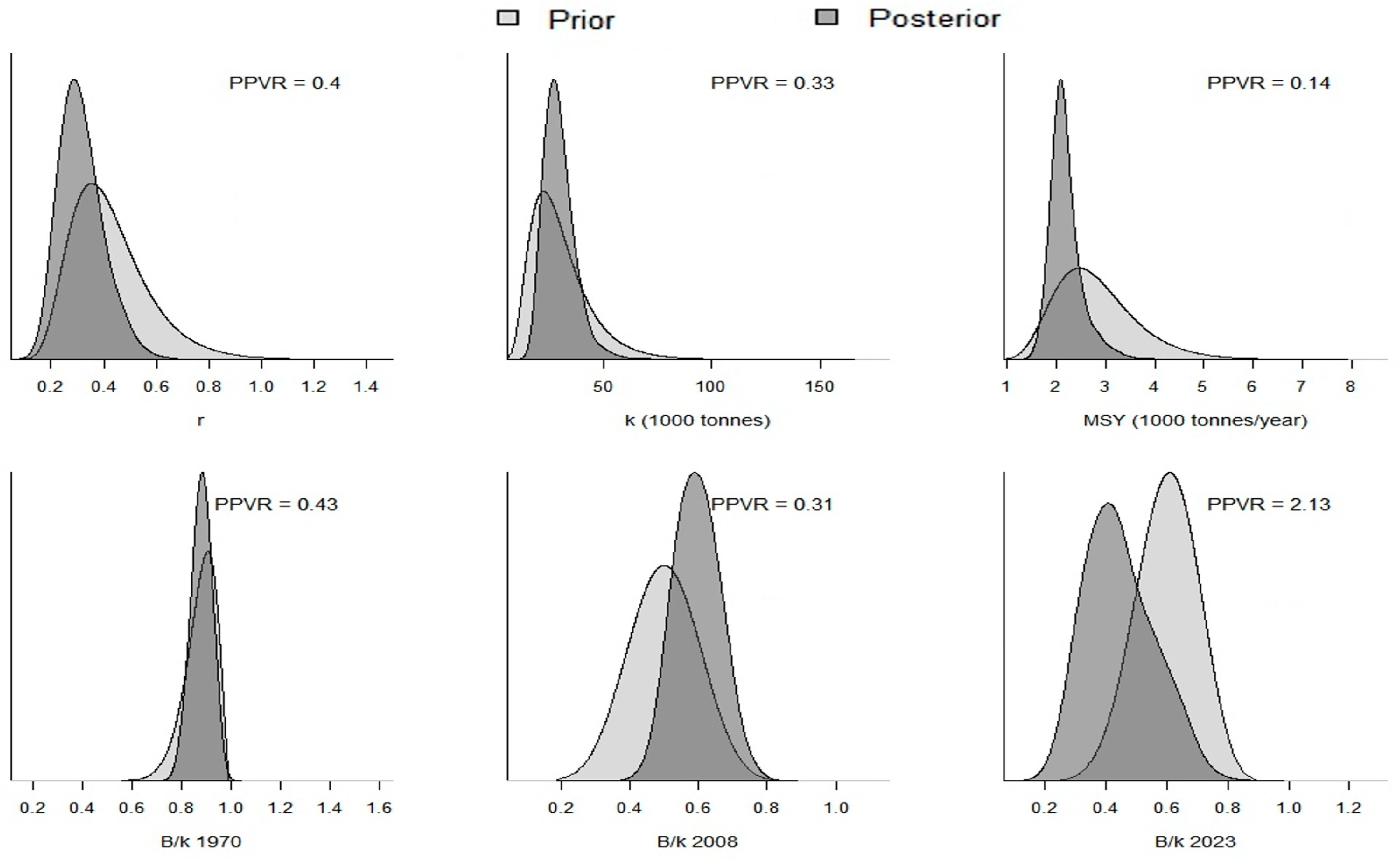

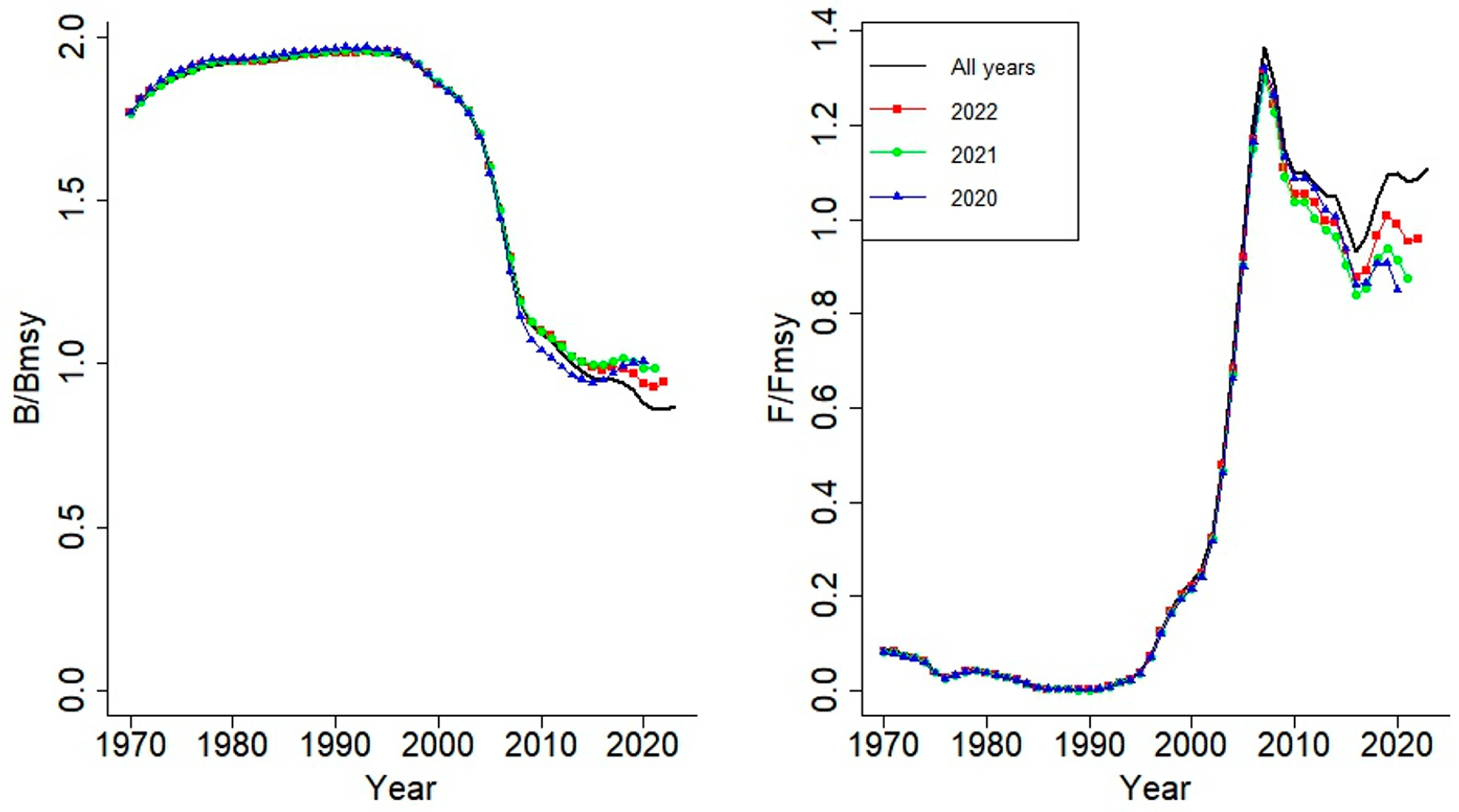

| Indicator | Baseline | Stock Level | Equations Used for Calculation |
|---|---|---|---|
| Total catch | Average for the applied period | Lower value than the baseline is better | 3 |
| Sales amount | Average for the applied period | Higher value than the baseline is better | 4 |
| Catch of fisheries subject to TAC | Catch limit (TAC) of the year | Lower value than the baseline is better | 3 |
| Mean size in catch | Maximum size for the applied period | Higher value than the baseline is better | 5 |
| Vulnerability due to non-TAC fisheries (catch of fisheries other than TAC fisheries) | Catch limit (TAC) of the year | Lower value than the baseline is better | 3 |
| Year | Total Catch | Sales Amount | Catch of Fisheries Subject to TAC | Mean Size in Catch | Vulnerability | |
|---|---|---|---|---|---|---|
| Average (tons) | Average (Thousand KRW) | TAC Quota (tons) | Max (CW, mm) | TAC Quota (tons) | ||
| Start | 1970 | 2362 | 29,328,667 | 1228 | 117.0 | 1228 |
| Intermediate | 2008 | 2362 | 29,328,667 | 1500 | 117.0 | 1500 |
| End | 2023 | 2362 | 29,328,667 | 978 | 117.0 | 978 |
| Year | Total Catch (tons) | Sales Amount (Thousand KRW) | Catch of Fisheries Subject to TAC (tons) | Mean Size in Catch (CW, mm) | Vulnerability (Others, tons) | |
|---|---|---|---|---|---|---|
| Start | 1970 | 247 | 29,328,667 | 247 | 117.0 | 24.7 |
| Intermediate | 2008 | 3019 | 43,209,026 | 1598 | 112.0 | 1424 |
| End | 2023 | 2063 | 49,441,766 | 563 | 117.0 | 1500 |
| Year | Total Catch | Sales Amount | Catch of Fisheries Subject to TAC | Mean Size in Catch | Vulnerability | |
|---|---|---|---|---|---|---|
| Start | 1970 | 0.10 | 1.00 | 0.20 | 1.00 | 0.02 |
| Intermediate | 2008 | 1.28 | 1.47 | 1.07 | 0.96 | 0.95 |
| End | 2023 | 0.87 | 1.69 | 0.58 | 1.00 | 1.53 |
| Year | Total Catch | Sales Amount | Catch of Fisheries Subject to TAC | Mean Size in Catch | Vulnerability | |
|---|---|---|---|---|---|---|
| Start | 1970 | 0.95 | 0.50 | 0.90 | 1.00 | 0.99 |
| Intermediate | 2008 | 0.36 | 0.74 | 0.47 | 0.96 | 0.53 |
| End | 2023 | 0.56 | 0.84 | 0.71 | 1.00 | 0.23 |
| Weight | 3 | 1 | 1 | 1 | 2 | |
| Year | B/k (Weighted Mean) | Range | ||
|---|---|---|---|---|
| Low | High | |||
| Start | 1970 | 0.9 | 0.75 | 1.0 |
| Intermediate | 2008 | 0.5 | 0.3 | 0.7 |
| End | 2023 | 0.6 | 0.4 | 0.8 |
| Parameter | PPVR | |
|---|---|---|
| TAC Data-Based CPUE | RS Data-Based CPUE | |
| r | 0.44 | 0.40 |
| k | 0.32 | 0.33 |
| MSY | 0.12 | 0.14 |
| B/k start | 0.40 | 0.43 |
| B/k intermediate | 0.29 | 0.31 |
| B/k end | 1.05 | 2.13 |
Disclaimer/Publisher’s Note: The statements, opinions and data contained in all publications are solely those of the individual author(s) and contributor(s) and not of MDPI and/or the editor(s). MDPI and/or the editor(s) disclaim responsibility for any injury to people or property resulting from any ideas, methods, instructions or products referred to in the content. |
© 2025 by the authors. Licensee MDPI, Basel, Switzerland. This article is an open access article distributed under the terms and conditions of the Creative Commons Attribution (CC BY) license (https://creativecommons.org/licenses/by/4.0/).
Share and Cite
Eom, J.-H.; Lee, S.-I.; Yoon, S.-C. A Quantitative Approach to Prior Setting for Relative Biomass (B/k) in CMSY++: Application to Snow Crabs (Chionoecetes opilio) in Korean Waters. Fishes 2025, 10, 400. https://doi.org/10.3390/fishes10080400
Eom J-H, Lee S-I, Yoon S-C. A Quantitative Approach to Prior Setting for Relative Biomass (B/k) in CMSY++: Application to Snow Crabs (Chionoecetes opilio) in Korean Waters. Fishes. 2025; 10(8):400. https://doi.org/10.3390/fishes10080400
Chicago/Turabian StyleEom, Ji-Hyun, Sung-Il Lee, and Sang-Chul Yoon. 2025. "A Quantitative Approach to Prior Setting for Relative Biomass (B/k) in CMSY++: Application to Snow Crabs (Chionoecetes opilio) in Korean Waters" Fishes 10, no. 8: 400. https://doi.org/10.3390/fishes10080400
APA StyleEom, J.-H., Lee, S.-I., & Yoon, S.-C. (2025). A Quantitative Approach to Prior Setting for Relative Biomass (B/k) in CMSY++: Application to Snow Crabs (Chionoecetes opilio) in Korean Waters. Fishes, 10(8), 400. https://doi.org/10.3390/fishes10080400







